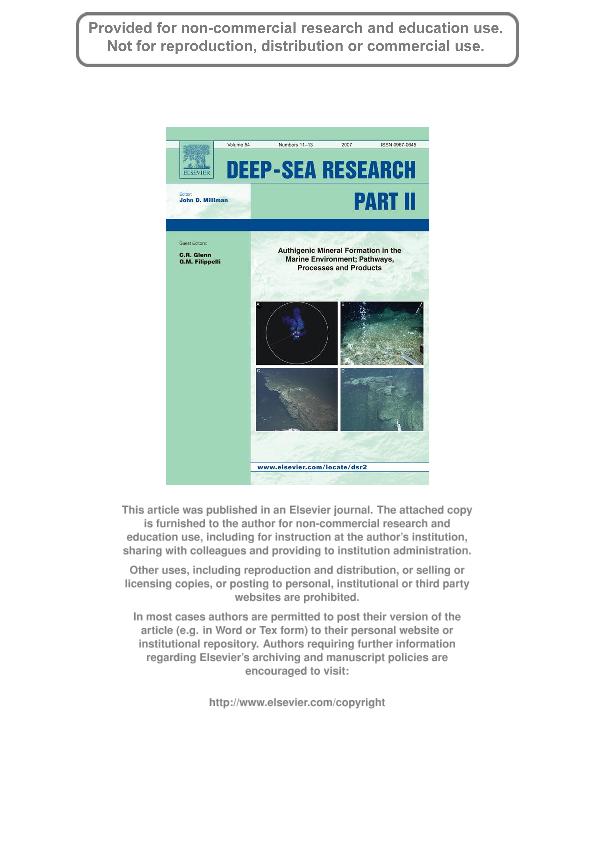Mostrar el registro sencillo del ítem
dc.contributor.author
Fazio, Ana Maria

dc.contributor.author
Scasso, Roberto Adrian

dc.contributor.author
Castro, Liliana Norma

dc.contributor.author
Carey, S.
dc.date.available
2019-06-11T21:02:11Z
dc.date.issued
2007-06
dc.identifier.citation
Fazio, Ana Maria; Scasso, Roberto Adrian; Castro, Liliana Norma; Carey, S.; Geochemistry of rare earth elements in early-diagenetic miocene phosphatic concretions of Patagonia, Argentina: Phosphogenetic implications; Pergamon-Elsevier Science Ltd; Deep Sea Research Part II: Topical Studies in Oceanography; 54; 11-13; 6-2007; 1414-1432
dc.identifier.issn
0967-0645
dc.identifier.uri
http://hdl.handle.net/11336/77993
dc.description.abstract
Phosphatic concretions in the Early Miocene, shallow marine, clastic deposits of the Gaiman Formation (Gaiman Fm.) show typical major element ratios, rare earth element (REE) patterns, and total REE contents. These characteristics are similar within different stratigraphic levels and geographic locations of the unit in central-north Patagonia, Argentina and suggest a common process for the origin of the concretions. Major element oxides in concretions are grouped into a "clastic" group (Si, Al, Ti, K and Fe), that mostly corresponds to the silicates in the terrigenous fraction, and an "authigenic" group (P, Ca and total REEs), that corresponds to authigenic francolite and calcite. Mn is the only element that exhibits a separate behavior, most likely because of its high mobility in seawater. Major element ratios in host shales are similar to those of the clastic fraction within the concretions and coquinas. Concretions are slightly depleted in LREEs and slightly enriched in HREEs in comparison to shales and display a weak negative Ce anomaly. Their La/Yb and La/Sm ratios indicate REEs incorporation from pore water without strong postdepositional recrystallization or strong adsorption. Y anomalies and La/Nd ratios in concretions are equivalent to seawater or slightly lower, suggesting that Gaiman concretions did not undergo intense diagenesis, but they were probably formed from phosphatic solutions impoverished in Y and La as a result of REEs release to solution from organic complexes in the early diagenesis. Flat, linear REE patterns also support an early-diagenetic origin for the concretions, via quantitative precipitation of phosphate from oxic-suboxic pore waters. Water circulation through burrows at the Miocene seawater-sediment interface improved ion diffusion and pore water renewal in the sediments, allowing the development of a widened early-diagenetic oxic-suboxic zone and the precipitation of phosphate with a homogeneous REE pattern.
dc.format
application/pdf
dc.language.iso
eng
dc.publisher
Pergamon-Elsevier Science Ltd

dc.rights
info:eu-repo/semantics/openAccess
dc.rights.uri
https://creativecommons.org/licenses/by-nc-sa/2.5/ar/
dc.subject
Argentina
dc.subject
Concretions
dc.subject
Miocene
dc.subject
Patagonia
dc.subject
Phosphate
dc.subject
Phosphogenesis
dc.subject
Rare Earth Elements
dc.subject.classification
Meteorología y Ciencias Atmosféricas

dc.subject.classification
Ciencias de la Tierra y relacionadas con el Medio Ambiente

dc.subject.classification
CIENCIAS NATURALES Y EXACTAS

dc.title
Geochemistry of rare earth elements in early-diagenetic miocene phosphatic concretions of Patagonia, Argentina: Phosphogenetic implications
dc.type
info:eu-repo/semantics/article
dc.type
info:ar-repo/semantics/artículo
dc.type
info:eu-repo/semantics/publishedVersion
dc.date.updated
2019-05-02T17:56:58Z
dc.journal.volume
54
dc.journal.number
11-13
dc.journal.pagination
1414-1432
dc.journal.pais
Países Bajos

dc.journal.ciudad
Amsterdam
dc.description.fil
Fil: Fazio, Ana Maria. Consejo Nacional de Investigaciones Científicas y Técnicas. Oficina de Coordinación Administrativa Ciudad Universitaria. Instituto de Geociencias Básicas, Aplicadas y Ambientales de Buenos Aires. Universidad de Buenos Aires. Facultad de Ciencias Exactas y Naturales. Instituto de Geociencias Básicas, Aplicadas y Ambientales de Buenos Aires; Argentina
dc.description.fil
Fil: Scasso, Roberto Adrian. Consejo Nacional de Investigaciones Científicas y Técnicas. Oficina de Coordinación Administrativa Ciudad Universitaria. Instituto de Geociencias Básicas, Aplicadas y Ambientales de Buenos Aires. Universidad de Buenos Aires. Facultad de Ciencias Exactas y Naturales. Instituto de Geociencias Básicas, Aplicadas y Ambientales de Buenos Aires; Argentina
dc.description.fil
Fil: Castro, Liliana Norma. Universidad de Buenos Aires. Facultad de Ciencias Exactas y Naturales. Departamento de Ciencias Geológicas; Argentina
dc.description.fil
Fil: Carey, S.. University Of Rhode Island; Estados Unidos
dc.journal.title
Deep Sea Research Part II: Topical Studies in Oceanography

dc.relation.alternativeid
info:eu-repo/semantics/altIdentifier/doi/http://dx.doi.org/10.1016/j.dsr2.2007.04.013
dc.relation.alternativeid
info:eu-repo/semantics/altIdentifier/url/https://www.sciencedirect.com/science/article/pii/S096706450700104X
Archivos asociados
